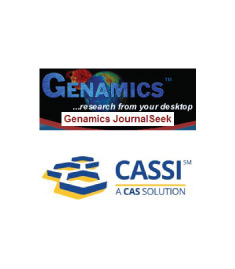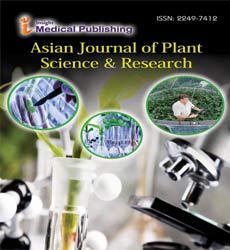ISSN : 2249 - 7412
Asian Journal of Plant Science & Research
Working on Supplement Catch from Soil by the Hereditary Control of Harvest Plants
Vijay Chandra*
Department of Plant Biochemistry, University of North Bengal, West Bengal, India
*Corresponding Author:Vijay Chandra
Department of Plant Biochemistry, University of North Bengal, West Bengal, India
E-mail:Chandra_V@ned.in
Received date: January 25, 2022, Manuscript No. AJPSKY-22-12703; Editor assigned date: January 27, 2022, PreQC No. AJPSKY-22-12703 (PQ); Reviewed date: February 08, 2022, QC No. AJPSKY-22-12703; Revised date: February 18, 2022, Manuscript No. AJPSKY-22-12703 (R); Published date: February 25, 2022, DOI: 10.36648/2249-7412.12.2.008.
Citation: Chandra V (2022) Working on Supplement Catch from Soil by the Hereditary Control of Harvest Plants. Asian J Plant Sci Res Vol.12 No.2: 008.
Description
Rusts brought about by commit microbes of wheat are yellow rust, stem rust which taint the foliage, stem and once in a while the spikes lost more than $5bilion in every year. They have the ability to form into inescapable pandemics and complex life cycles that include substitute hosts and a few spore stages bringing about yield misfortunes of 30-half sensitive and semi touchy cultivars and 57%-97%. Wheat stripe rust, brought about by is one of the most inescapable, damaging and an arising genuine infection, particularly in cool environments, present in practically all the wheat developing regions and an imposing danger to worldwide wheat creation, are wheat mono trimming and the most common to yellow rust illness scourges which causes 57%-97% of yield misfortunes in touchy and semi delicate bread wheat cultivars [1,2].
Convenient Use of Fungicides
Use of foliar fungicides is significant components to control wheat yellow rust and lessen yield misfortunes. As per discoveries relatively better yields were acquired on showered medicines rather than unsprayed medicines under test condition. During the fungicide application; helpfulness of climate to rust, varietal obstruction, adequacy and timing of fungicide application to be thought about in diminishing the sickness seriousness and pace of pandemic turn of events. Enormous scope business and government-run wheat ranches have commonly decided to establish rust-helpless wheat assortments since they have a more noteworthy yield capability of 20%-25% and 36.6%-51.1% than rust proof assortments. Wheat filled in a better return potential (good country) climate might be bound to deliver a yield reaction [3].
Convenient use of fungicides actually forestalls yield misfortunes and further spread of the illness to the wheat creation locales, and possibly gigantic cross country yield misfortune was stayed away from through utilization of fungicides. Fungicide costs impact the choice of showering or not splashing. Notwithstanding, when the infection seriousness is low, crop yield is typically not affected. The advantage from fungicide applications in crop creation is reflected in the profits of up to multiple times the expense in question. There is a confusion that fungicides are utilized to get a "yield knock" yet most harvest researchers concur that fungicides basically safeguard yield potential. At the point when sickness seriousness can possibly lessen crop yields, then at that point, fungicide applications might assist with safeguarding the harvest from likely misfortunes [4]. Then again on the off chance that sickness seriousness is low and there is insignificant yield misfortune applying a fungicide won't bring about either a yield or monetary benefit. In the significant examinations analysts accentuated that there are various elements that ranchers ought to consider prior to settling on a fungicide splash choice, including yield potential, wheat cost, fungicide cost and infection pressure. Albeit numerous ranchers and private wheat producers shower when the rust happened disregarding monetary edge level of the illness and positive net profit from the financial yield of wheat. The principle objective of this exploration was to decide the productivity of wheat yield utilizing fungicides against yellow rust in helpless, tolerably defenseless, respectably assortments and contrasting and business somewhat safe wheat assortments. The examinations were spread out in Randomized Complete Block Design (RCBD) in factorial course of action with three replications. Four bread wheat cultivars which were chosen based reaction of response being defenseless. Every one of the assortments were planted at the suggested pace of 100 kg seed ha-1 to six column plots of 2.5 m length and 1.2 m width with 20 cm between line separating [5]. The holes among plots and replications were 1 m and 1.5 m, separately. Spreader columns comprising of a combination of exceptionally helpless bread wheat assortments of Morocco, Kubsa and PBW 343 were planted in each line to guarantee uniform spread of inocula and adequate sickness advancement.
Foliar Fungicides
Foliar fungicides and its application costs were utilized to investigation productivity on the splashing of fungicides to four bread wheat cultivars. The normal cost of bread wheat cultivars were determined from information given by the Ethiopian farming and product promoting administration and normal neighborhood fungicide costs utilized were acquired by getting to nearby retailers and compound makers. Since rucksack fungicide application was concurred by contract between the cultivator and the business tools so adjuvant and surfactant, and apparatus [6].
The outcomes showed that lower monetary return was gotten because of dry climatic circumstances which brought about low degree of rust seriousness when contrasted with got greatest benefit to higher height with cooler environment, lower temperature, weighty dew and irregular downpours. This discoveries are advantageous with work done by demonstrated that helpful climatic circumstances to yellow rust sickness improvement during the developing season, cultivar obstruction, fungicide application recurrence, plant development stage, fungicide and fungicide application costs and the cost of wheat decides the net return in fungicide use of wheat. As per discoveries multiplying and significantly increasing the grain cost of bread wheat highest affected the net return from fungicide application, trailed by expanding fungicide cost [7]. All in all, productivity is reliant upon many variables, including weather patterns ideal for sickness advancement, the degree of illness power, ability of the fungicide applied in controlling every particular infection, fungicide and fungicide application expenses and rates, fungicide application timing, cultivar opposition, social practices and the cost of wheat. Presently a day, plausibility of delivering new safe assortment is troublesome because of intricacy of yellow rust and constantly evolvement of new races. In East Africa the current business wheat cultivars including as of late delivered assortments are defenseless to the new races and unrealistic to grow a beneficial yield of wheat without use of fungicides to the private areas, ranchers and government run wheat producers in Ethiopia. To get positive net returns, natural elements, varietal reaction to rust, adequacy and timing of fungicide application, cost of fungicide, wheat cost and horticultural practices ought to be thought about. The overall help given by the wheat rust exploration group particularly to obligated and profoundly appreciated for strategic and specialized help [8]. This showed that favorable climatic circumstances to yellow rust infection improvement during the developing season, cultivar obstruction, fungicide application recurrence, plant development stage, fungicide and fungicide application costs and the cost of wheat decides the net return in fungicide utilization of wheat. The outcomes from this study showed that foliar fungicide applications to bread wheat cultivars can be beneficial in two times application with touchy to semi sensitive(moderately defenseless to susceptible)varieties; notwithstanding, overall deficit can result assuming fungicides are as often as possible applied in with low infection seriousness or safe assortments rather than delicate and semi touchy assortments [9,10].
References
- Li FW, Nishiyama T, Waller M, Frangedakis E, Keller J, et al. (2020) Anthoceros genomes illuminate the origin of land plants and the unique biology of hornworts. Nature Plants 6: 259-272. [Crossref], [Google Schoar], [Indexed]
- Crick F (1970) Central dogma of molecular biology. Nature 227: 561-563. [Crossref], [Google Schoar], [Indexed]
- Bird A (2007) Perceptions of epigenetics. Nature 447: 396-398. [Crossref], [Google Schoar], [Indexed]
- Tarekegn A, Tanner DG, Gebeyehu G (1995) Improvement in yield of bread wheat cultivars released in Ethiopia from 1949 to 1987. African Crop Sci J 3: 41-49 [Crossref], [Google Schoar]
- Whittaker RH (1969) New concepts of kingdoms or organisms. Science 163: 150-160. [Crossref], [Google Schoar], [Indexed]
- Dubey K, Ko C (2008) The genus tetraleurodes cockerell (Hemiptera: Aleyrodidae) of Taiwan. PROC Bionee Org 110: 760–777. [Crossref], [Google Schoar]
- Sundararaj R, Vimala D (2018) New record of the legume feeding whitefly tetraleurodes acaciae (Quaintance) (Hemiptera: Aleyrodidae) from India. Indian J Entomol 80: 1168-1169. [Crossref], [Google Schoar]
- Waterworth WM, Masnavi G, Bhardwaj RM, Jiang Q, Bray CM, et al. (2010) A plant DNA ligase is an important determinant of seed longevity. Plant J 63: 848–860. [Crossref], [Google Scholar], [Indexed]
- Yoshiyama KO (2016) SOG1: A master regulator of the DNA damage response in plants. Genes and Genetic Systems 90: 209-216. [Crossref], [Google Scholar], [Indexed]
- Michael TP, Jackson S (2013) The first 50 plant genomes. The Plant Genome 6: 4-5. [Crossref], [Google Scholar]

Open Access Journals
- Aquaculture & Veterinary Science
- Chemistry & Chemical Sciences
- Clinical Sciences
- Engineering
- General Science
- Genetics & Molecular Biology
- Health Care & Nursing
- Immunology & Microbiology
- Materials Science
- Mathematics & Physics
- Medical Sciences
- Neurology & Psychiatry
- Oncology & Cancer Science
- Pharmaceutical Sciences
